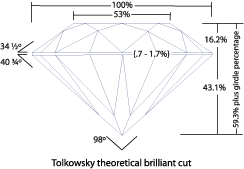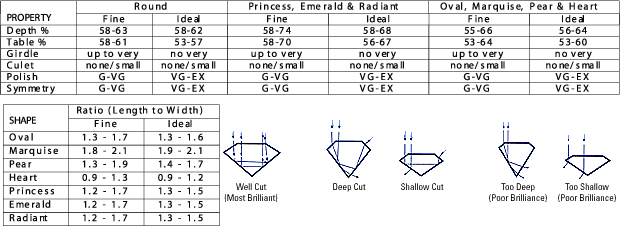Recommended Cutting Guidelines
 In 1919, a 19 year old student, Marcel Tolkowsky, working on his master’s thesis, wanted to see, as a mathematician, if it were possible to establish a scientific basis for the perfect cut, based on the diamond’s ability to refract light. He confirmed what the better cutters were seeing: if you cut the diamond to take advantage of the way it bends light, you have more brilliance and fire. Of course to do this means more of the diamond is cut away, so a finished product won’t weight as much. It takes much longer to make all the angles just right. In other words, it costs more to produce.
In 1919, a 19 year old student, Marcel Tolkowsky, working on his master’s thesis, wanted to see, as a mathematician, if it were possible to establish a scientific basis for the perfect cut, based on the diamond’s ability to refract light. He confirmed what the better cutters were seeing: if you cut the diamond to take advantage of the way it bends light, you have more brilliance and fire. Of course to do this means more of the diamond is cut away, so a finished product won’t weight as much. It takes much longer to make all the angles just right. In other words, it costs more to produce.
These percentages are calculated from the average cross-sectional size of the diamond as reflected by the average diameter. The depth percentage is measurement of depth divided by diameter. The ideal depth for a round brilliant is 60%. From time to time, round diamonds are encountered that are not exactly round.
 If the diameter extremes vary by more than 2% the diamond is out of round. The novice shopper frequently overlooks this point.
If the diameter extremes vary by more than 2% the diamond is out of round. The novice shopper frequently overlooks this point.
The table percentage demonstrates how much of the cross-sectional area is table and how much is crown angle. The ideal table is 53% and is infrequently encountered. A “trade ideal” of 60% table is frequently seen and acceptable in most fine jewelry circles. The smaller table diamonds are more expensive to produce but are sought after by diamond fanciers because of the larger prism (greater area of crown angle) capable of dividing light into its spectral colors created by the smaller table.
Many students are curious as to how the table is measured since it is an octagon. A microscopic millimeter “ruler” is placed over the table and the measurement taken point to opposite point of the octagon. A method of visual inspection of the two squares that make up the octagon. Visual estimates of table size can be made (with practice) depending upon the degree to which the sides of these squares bow in or bulge out.



